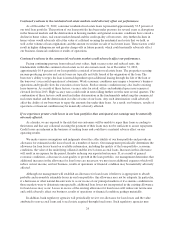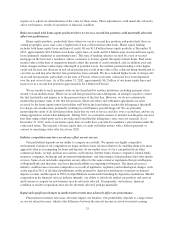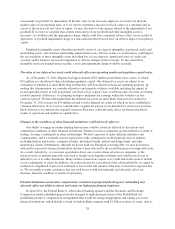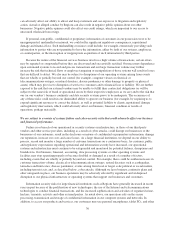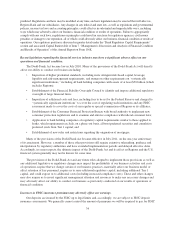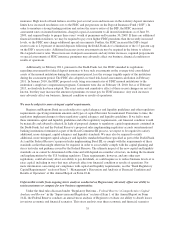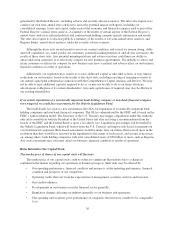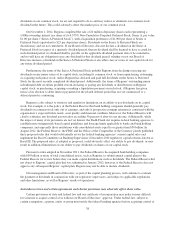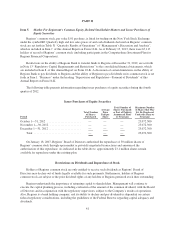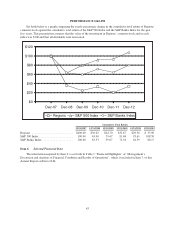Regions Bank 2012 Annual Report Download - page 49
Download and view the complete annual report
Please find page 49 of the 2012 Regions Bank annual report below. You can navigate through the pages in the report by either clicking on the pages listed below, or by using the keyword search tool below to find specific information within the annual report.Risks Arising From the Legal and Regulatory Framework in which Our Business Operates
Increased litigation could result in legal liability and damage to our reputation.
We and certain of our subsidiaries have been named from time to time as defendants in various class actions and
other litigation relating to their business and activities. Past, present and future litigation have included or could include
claims for substantial compensatory or punitive damages or claims for indeterminate amounts of damages. We and
certain of our subsidiaries are also involved from time to time in other reviews, investigations and proceedings (both
formal and informal) by governmental and self-regulatory agencies regarding our and their business. These matters
also could result in adverse judgments, settlements, fines, penalties, injunctions or other relief.
In addition, in recent years, a number of judicial decisions have upheld the right of borrowers to sue lending
institutions on the basis of various evolving legal theories, collectively termed “lender liability.” Generally,
lender liability is founded on the premise that a lender has either violated a duty, whether implied or contractual,
of good faith and fair dealing owed to the borrower or has assumed a degree of control over the borrower
resulting in the creation of a fiduciary duty owed to the borrower or its other creditors or shareholders.
Substantial legal liability or significant regulatory action against us or our subsidiaries could materially
adversely affect our business, financial condition or results of operations or cause significant harm to our
reputation. Additional information relating to litigation affecting Regions and our subsidiaries is discussed in
Note 23 “Commitments, Contingencies and Guarantees” to the consolidated financial statements of this Annual
Report on Form 10-K.
We may face significant claims for indemnification in connection with our sale of Morgan Keegan in 2012.
On January 11, 2012, Regions entered into a stock purchase agreement to sell Morgan Keegan and related
affiliates to Raymond James Financial, Inc. (“Raymond James”). The transaction closed on April 2, 2012. In
connection with the closing of the sale, Regions agreed to indemnify Raymond James for all litigation and certain
other matters related to pre-closing activities of Morgan Keegan. Indemnifiable losses under the indemnification
provision include legal and other expenses, such as costs for defense, judgments, settlements and awards
associated with the resolution of litigation related to pre-closing activities. As of December 31, 2012 the carrying
value of the indemnification obligation is approximately $345 million. This amount reflects an estimate of
liability, and actual liabilities can potentially be higher than amounts reserved. The amount of liability that we
may ultimately incur from indemnification claims may have an adverse impact, perhaps materially, on our results
of operations.
We are subject to extensive governmental regulation, which could have an adverse impact on our operations.
The banking industry is extensively regulated and supervised under both federal and state law. Regions and
Regions Bank are subject to the regulation and supervision of the Federal Reserve, the FDIC, the Consumer
Financial Protection Bureau and the Superintendent of Banking of the State of Alabama. These regulations are
intended primarily to protect depositors, the public and the FDIC insurance fund, and not our shareholders. These
regulations govern a variety of matters, including certain debt obligations, changes in control of bank holding
companies and state-chartered banks, maintenance of adequate capital by bank holding companies and state-
chartered banks, and general business operations and financial condition of Regions and Regions Bank (including
permissible types, amounts and terms of loans and investments, the amount of reserves against deposits,
restrictions on dividends, establishment of branch offices, and the maximum interest rate that may be charged by
law). Additionally, all of our non-bank subsidiaries are subject to oversight by the Federal Reserve, and certain of
our other subsidiaries are subject to regulation, supervision and examination by other regulatory authorities, such
as state insurance departments.
As a result, we are subject to changes in federal and state law, as well as regulations and governmental
policies, income tax laws and accounting principles. Regulations affecting banks and other financial institutions
are undergoing continuous review and frequently change, and the ultimate effect of such changes cannot be
33



